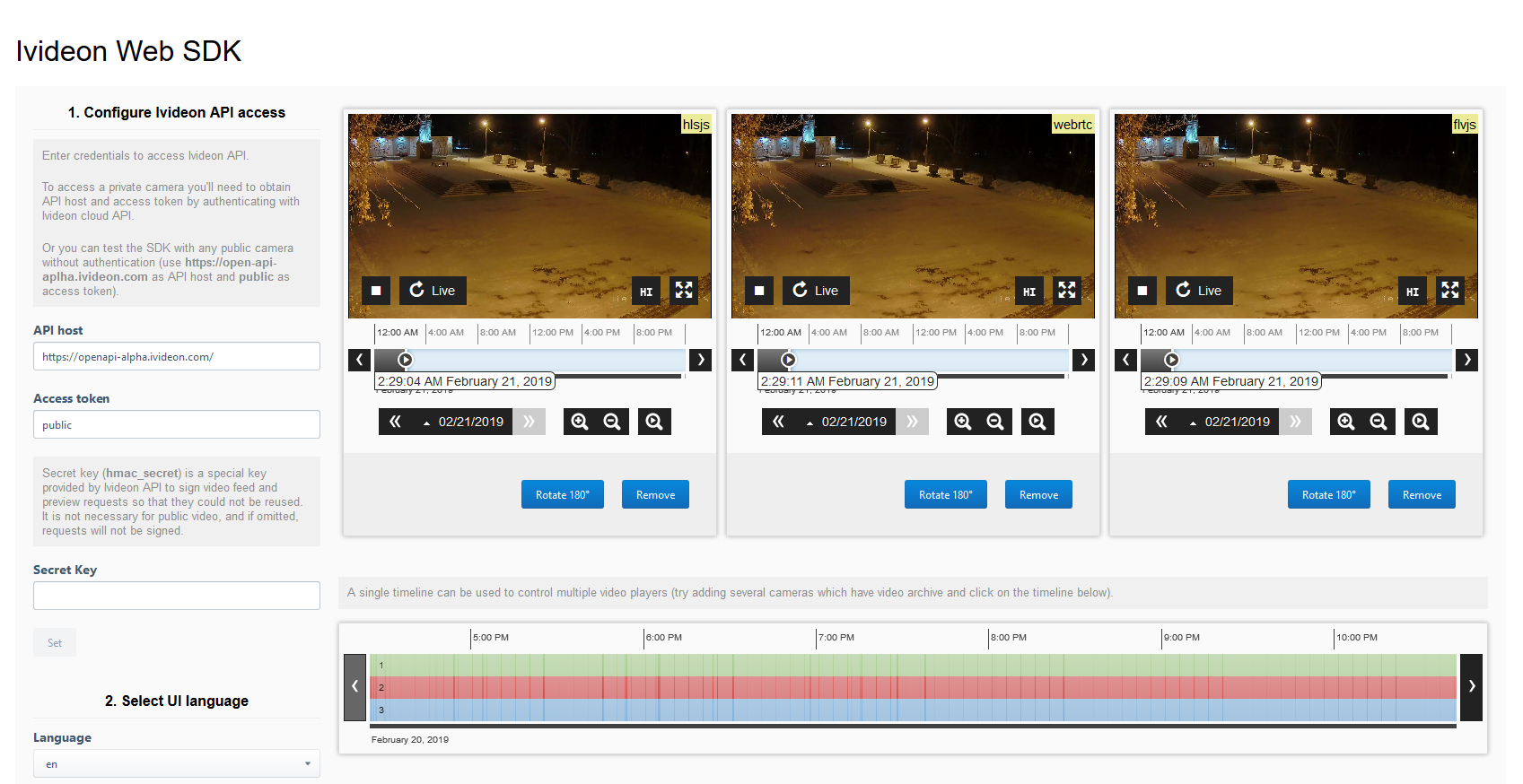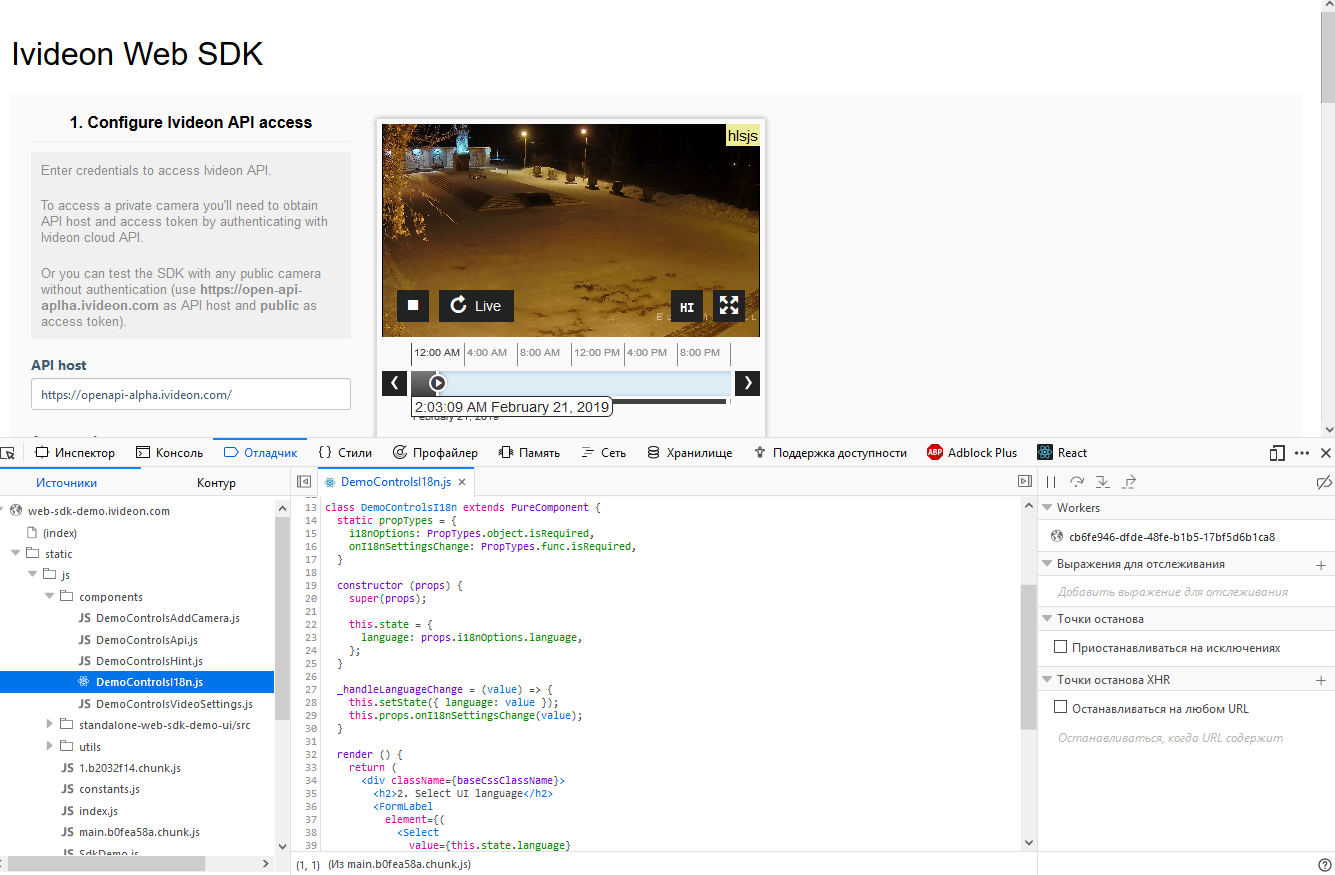Doing cloud-based video surveillance do-it-yourself: new Ivideon Web SDK features

We have several integration components that allow any partner to create their own products: Open API to develop any alternative to the Ivideon user account, Mobile SDK, with which you can develop a complete solution that is equivalent in functionality to Ivideon applications, as well as the Web SDK.
We recently released an improved Web SDK with a new documentation system and demo application that will make our platform even more flexible and convenient for developers. If you have already been familiar with our SDK before, you will immediately notice the changes - now you have a good example of how to embed API functions in your application.
')
For everyone else, we’ll tell you more about everyday cases and implemented integrations using the Ivideon API / SDK.
Web SDK: New Features
Ivideon is not just a cloud-based video surveillance service and equipment provider. Inside Ivideon there is a full development cycle: from camera firmware to the web version of the service. We do client and server SDK, improve LibVLC, implement WebRTC, work on video analytics, develop a client with implemented White Label support for partners and demo projects to the SDK.
As a result, we managed to become a platform on the basis of which partners can create their own solutions. Now our Web SDK has received a major upgrade, and we hope that there will be even more integration solutions.
For your convenience, we have added the “Quick Start” section to the beginning, which will help you easily understand the device management.
The code below demonstrates the basic use of the Ivideon Web SDK: a player has been added to the page, and the video has been played for the public camera.
<!DOCTYPE html> <html> <head> <title>Ivideon WEB SDK example</title> <link rel="stylesheet" href="/vendor/ivideon-web-sdk-1.0.0/iv-standalone-web-sdk.css" /> <script src="/vendor/ivideon-web-sdk-1.0.0/iv-standalone-web-sdk.js"></script> </head> <body> <div class="myapp-player-container" style="max-width: 640px;"></div> <script> _ivideon.sdk.init({ rootUrl: 'https://<your-domain>/vendor/ivideon-web-sdk-1.0.0/', i18nOptions: { availableLanguages: [ 'de', 'en', 'fr', ], language: 'en', } }).then(function (sdk) { sdk.configureWithCloudApiAuthResponse({ api_host: 'openapi-alpha.ivideon.com', access_token: 'public', }); // `id` used below is not an actual camera ID. Replace it with your own. var camera = sdk.createCamera({ id: '100-481adxa07s5cgd974306aff47e62b639:65536', cameraName: 'Demo Cam', imageWidth: 800, imageHeight: 450, soundEnabled: true, }); var player = sdk.createPlayer({ container: '.myapp-player-container', camera: camera, defaultControls: true, playerEngine: sdk.playerEngines.PLAYER_ENGINE__WEBRTC, }); player.playLive(); }, function (error) { console.error(error); }); </script> </body> </html> We also added some new features:
- support for one-time video links;
- buttons have been added to the player to control video quality and archive playback speed;
- Player controls can be turned on and off one at a time (before, you could either turn on everything that is, or hide everything);
- Added the ability to turn off the sound on the camera.
Demo application
To demonstrate how to use the Ivideon Web SDK with the user interface library, we distribute it with the demo application. Now you have the opportunity to see how Ivideon Web SDK works with ReactJS.
Demo application is available online by the link . For his work is added a random camera from Ivideon TV. If suddenly the camera is inoperative, just follow the link above again.
Another way to familiarize yourself with the demo is to examine the source code in the Web SDK and build the application yourself.
Our application can show which code corresponds to the user's actions.
Add to the page several players with different engines and compare their work.

Create multiple players and manage them from one timeline, which will simultaneously display archives of recordings of several cameras.

The demo application remembers the settings from the last session in the local storage of the browser: API access settings, camera settings, and others. When you re-enter, they will be restored.
The demo application code is compiled from source maps - the demo code can be viewed directly in the debugger.

Integration Examples

The program group with the prefix " iSKI " includes individual applications for almost all European ski countries: iSKI Austria, iSKI Swiss, iSKI France, iSKI Italia (Czech, Slovakia, Suomi, Deutschland, Slovenija and more). The application shows the state of snow in the ski resorts, a list of restaurants in the mountains and the scheme of trails, as well as other useful information that will help you get a complete picture of your destination before the trip. At the same time, access to the Internet is not needed - it works in offline mode (except for broadcasting from cameras). All applications are available for free.
Now, almost every ski resort is equipped with a camera showing the situation on the slope. To view the cameras remotely through the application, we provided iSKI with our SDK, and now everyone can see through the application not only the weather forecast, the thickness of the snow cover and the number of open lifts, but also the video directly from the slope.

Different systems of smart home. Thanks to integration with the Ivideon system, these solutions gain more security benefits for the home, as they control the home and save the video in the safest way in the cloud archive. Full control is carried out through a mobile application that notifies you of any threats in real time and allows you to quickly respond to non-standard situations.

Analytics system of work of sellers and consultants of Perfect Service Solution. The cloud-based video surveillance system observes and records data in the archive, which is checked by operators, and the results are reflected online in the personal account. The client as a result receives a short fragment with a specific event - violation of the sales protocol or a controversial incident. In the web interface, he sees the violation data and the embedded video slice. The entire data array is divided into two categories: critical events and regular ones. Regular ones appear in the online office the day after the event, but for critical violations, reports can be received via SMS or in the messenger.
Email us to access the Web SDK and learn more about our integration capabilities.
Source: https://habr.com/ru/post/445788/
All Articles